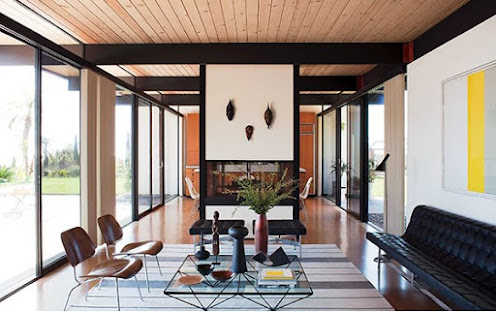Introduction:-
Mid-century
modern interior design is a style that has experienced a resurgence in
popularity over the last few decades, but its origins date back to the mid-20th
century, particularly from the 1940s to the 1960s. This design movement
represents a dramatic departure from the ornate and cluttered aesthetics of the
past, embracing clean lines, functionality, and a deep connection to the
outdoors. Characterized by minimalist shapes, innovative materials, and a sense
of warmth and accessibility, mid-century modern design became a symbol of
optimism and progress in post-war America and continues to influence interior
design today.
At the
heart of mid-century modern design is the emphasis on clean, straight lines and
simple, geometric forms. Furniture was designed with an emphasis on function
rather than unnecessary ornamentation. Curved shapes and angular lines were
commonly seen in everything from furniture to architectural details. This
simplicity was not about austerity but rather an effort to create spaces that
were efficient and easy to navigate, with a sense of visual clarity.
2. Open Floor Plans and
Indoor-Outdoor Flow:-
One of the
most defining aspects of mid-century modern interiors was the concept of open
floor plans. Homes were designed to be spacious and open, with rooms that
flowed seamlessly into one another. Walls were minimized, and large windows
were incorporated to create a feeling of openness and to invite natural light
into the home. These expansive windows often provided views of the surrounding
nature, creating a seamless connection between the indoors and outdoors. This
was particularly evident in mid-century modern homes that incorporated elements
of the "California ranch" style, where the idea of bringing the
outdoors inside was highly emphasized.
3. Use of Natural Materials:-
While
mid-century modern design embraced new materials such as molded plywood,
fiberglass, and metal, it also celebrated the use of natural materials like
wood, stone, and leather. Wooden furniture, especially teak and walnut, became
synonymous with the style, contributing a sense of warmth and richness to
spaces that otherwise relied on minimalist aesthetics. These natural materials
were often left in their natural state, allowing the grain and texture of the
wood to remain visible and add character to the furniture and architectural
details.
4. Functionality and
Practicality:-
Mid-century
modern interiors were designed with a strong focus on practicality. Furniture
was crafted to be functional and versatile, with pieces that could serve
multiple purposes. For example, storage units were integrated into walls, and
tables were designed with clean lines and simple mechanisms to be easily moved
or adjusted. This practicality extended to the layout of the interiors, where
spaces were arranged for ease of movement and usability. The idea was that
design should make life easier and more efficient, not just aesthetically
pleasing.
Conclusion:-
Mid-century
modern interior design remains one of the most beloved and influential design
styles to this day. Its emphasis on simplicity, functionality, and a connection
to the natural world continues to resonate with homeowners and designers alike.
Through clean lines, innovative materials, and an elegant use of space,
mid-century modernism transformed the way we think about home interiors, laying
the groundwork for many of the design trends that followed. Its timeless appeal
and focus on both beauty and utility ensure that mid-century modern design will
continue to inspire for generations to come.
"This Content Sponsored by Genreviews.Online
Genreviews.online is One of the Review Portal Site
Website Link: https://genreviews.online/
Sponsor Content: #genreviews.online, #genreviews, #productreviews, #bestreviews, #reviewportal"




.jpg)
No comments:
Post a Comment